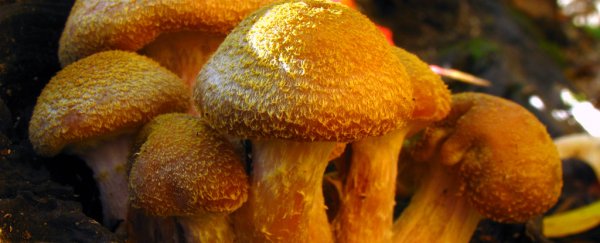When you think of vast organisms, it's hard not to think of giants like blue whales and redwood trees. But back in the 1980s, it was a single mushroom that broke records and forced a rethink on what it means to be an individual organism.
A team of scientists from the US and Canada recently went back to the site of this vast, sprawling web of hyphae to take a look at the fungus's genes, only to discover it's bigger than previously recorded, and far older.
The brownish-yellow caps of the honey mushroom (Armillaria gallica) are a relatively common sight on dead and dying trees across North America. But what seem to be individual mushrooms are often just the tips of a real behemoth – a buried network of fibres representing the organism itself.
In 1988, researchers started to run genetic tests on honey mushroom specimens from a forest in Crystal Falls, Michigan. They quickly realised the fleshy caps covering the forest floor were clones, emerging as reproductive organs from the same organism.
Initial estimates figured this single living thing's mass had to be around 100,000 kilograms (220,000 pounds), with its root-like hyphae winding their way through some 120,000 square metres (about 30 acres) of forest.
Scratch that.
The latest analysis puts its mass at around 400,000 kilograms (880,000 pounds), covering around 370,000 square metres (about 90 acres), making it heavier than a blue whale and as large as a supersized shopping mall.
Nothing gets this big overnight. Once thought to be about 1,500 years old, it's now believed to have been a mere spore when the ancient Greeks were first pondering the nature of life, the Universe, and everything around 2,500 years ago.
But apart from its immensity and old age, the team found a particularly interesting surprise in the lab. They sequenced the genomes of 15 samples of this famous example of honey mushroom and compared their DNA for differences.
Since all cells were already known to be cloned from the same body, it came as little surprise that they were all virtually identical. A little too identical, in fact.
Despite centuries of steady growth, just 163 of the 100 million bases making up its genetic code had changed - something was keeping this thing from evolving.
It's not all that clear what it might be; whether some fancy biochemical mechanisms are at work, or simply the fact most of this humongous fungus lives underground, hidden away from mutating forces of nature.
And if all of this is not crazy enough, there's one more thing.
It's not even the biggest fungus we know of.
When the fungus was found, it broke 'world's widest organism' records at the time, but that crown wasn't kept for very long. In 1998, an even bigger cloned network of honey mushrooms was discovered in Oregon's Blue Mountains.
This new study is available on the website bioarxiv.org and yet to be peer-reviewed, so there could be room for debate.
But even with this latest analysis of its size, Michigan's Crystal Creek monster has no hope of snatching back its prize. Oregon's current record holder covers an insane 9.65 square kilometres (2,384 acres), and might be as old as civilisation itself, at just over 8,500 years.
Since the only way to get a grip on the size of these fungi is to compare their genomes, it's possible there are even bigger and older specimens out there hiding in plain sight.
Even if these two do happen to represent the limits of individual growth, they're forcing us to think twice about what it means to be a single living organism.
